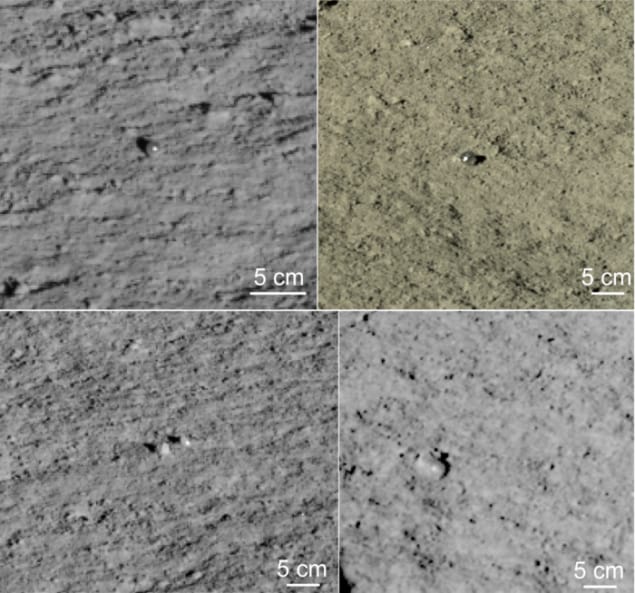
The Moon’s highlands may be scattered with transparent globules of a glass-like substance, say scientists involved in China’s Chang’e-4 mission. Initial observations from the mission’s Yutu-2 rover suggest that these structures are widespread, and their presence could help us better understand the early history of lunar impacts as well as providing sampling targets for future expeditions to the lunar surface.
The Chang’e-4 mission is exploring the South Pole-Aitken basin on the far side of the Moon. As part of this mission, Yutu-2 has travelled more than 1000 m across the Von Kármán crater since its deployment in early 2019. Reflectance spectra sent back by orbiters and Yutu-2 had previously revealed that the lunar soil, or regolith, in the basin is mainly iron-poor, with substantial amounts of an intrusive igneous rock known as anorthosite as well as coarse-grained rocks. Now, thanks to its panoramic camera, Yutu-2 has obtained images of transparent globules of a type never seen on the Moon before.
Dramatically different
Upon examining the images, a team led by Zhiyong Xiao of the Planetary Environmental and Astrobiological Research Laboratory at Sun Yat-sen University found that the globules ranged from light grey to brown in colour and were either spherical or dumbbell-shaped, measuring 1.5 to 2.5 cm in diameter. Although the Apollo astronauts also collected glassy globules from the lunar surface, their samples were mostly dark and opaque. The Apollo samples were also much bigger and contained a lot of clasts, which are fragments of older rock broken up and embedded in a younger one.
Xiao and colleagues say that the newly-discovered globules are very different from the blocky fragments that surround them. They speculate that they could have been created by high-energy impacts causing iron-poor materials such as pure anorthosites to melt. If this is indeed the case, the glassy deposits are likely to be widespread on the Moon’s far side, since pure anorthosites are a common component of the regolith in the vast lunar highlands and high-energy melts formed by impact events are abundant.
Globules might be extremely young
The shape and surface structure of the globules suggests that they may have formed (or been exposed) relatively recently, since surface materials on the Moon are continually being abraded and impacted. Indeed, growth rates of lunar regolith imply that the top 2-3 cm is completely overturned in less than 100 000 years. However, Xiao explains that the globules’ formation age cannot be calculated exactly based solely on their shape or surface structures.
The discovery of these globules on the Moon suggest that impacts on other planetary bodies could also form such “tektite-like” glasses. What is more, Xiao suggests that analysing their composition and isotope ages should yield valuable insights into the Moon’s impact history, since such impacts should have been common during the early years of Earth’s satellite. At this stage, however, the researchers are not able to confirm whether these structures are similar to tektites found here on Earth, where they were produced in craters large than 10 km across formed following impacts with water-rich targets.
Valuable sampling targets
Xiao’s team, which reports its work in Science Bulletin, say that the translucent globules on the Moon could provide valuable sampling targets for future lunar surface explorations, as they should be easy to recognize. They add that the globules could also be excellent raw materials from which to manufacture glass in situ, as they have good light-admitting quality.

Tracking China’s rapid rise in lunar exploration
The researchers are now analysing additional data returned by the Chang’e-4 mission, and hope to confirm the presence of other types of globules. “We are currently investigating the 500 mg of regolith samples returned by the Chang’e-5 mission (allocated to my group), in which hundreds of glass spherules (<500 𝜇m) have been discovered,” Xiao tells Physics World. “From the perspective of comparative planetology, we are combining our study of lunar glass spherules with our ongoing studies of tektites collected in southern China that belong to the vast Australasian strewn field. Our aim is to better understand the mechanisms by which various impact glasses form.”



